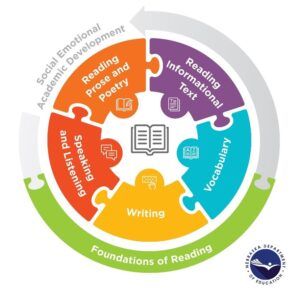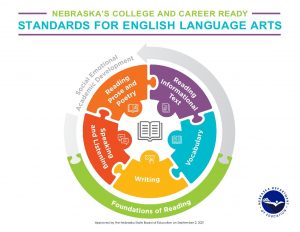Nebraska’s PK-12 students have equitable access to high-quality literacy instruction that prepares them for the demands of college, career, and civic life. Instructional practices are grounded in student engagement with complex and challenging texts and are responsive to a range of student needs and interests.
We Believe
- Excellent literacy instruction provides opportunities for all students to learn, regardless of their race, ethnicity, or any other part of their identity;
- A clear, required sequence of foundational skills is important and necessary to developing proficient readers who have the capacity to comprehend a variety of texts across disciplines;
- Every Nebraska student deserves access to high-quality, culturally responsive instructional materials that are aligned to state standards and instructional shifts;
- Deep engagement with rich, worthwhile texts and tasks builds students’ knowledge of the world;
- Providing frequent and meaningful opportunities to write about text is an effective practice that helps students develop the ability to think critically about the content and ideas presented in all disciplines;
- Content-area and disciplinary literacy are essential components of college, career, and civic readiness; and systematic vocabulary instruction in all content areas, across all grade levels, plays a critical role in successful reading comprehension.
Foundational Literacy
The Nebraska State Board of Education supports and encourages systemic efforts to improve foundational literacy, working to ensure that all students become successful readers and writers. The Nebraska State Board of Education believes that all schools should establish policies that promote high-quality early literacy instruction that is grounded in evidence-based practices and that highlights the importance of grade- level reading. Foundational literacy instruction is essential to ensure all children become successful readers and writers. All students, including students with disabilities, English learners, and high-ability learners should have access to high-quality instructional materials and instruction.
English Language Arts Quick Links
News & Notes
Support for Adolescent Literacy provided by The Reading League
Adolescent students often struggle with reading due to a combination of underlying factors, including inadequate foundational literacy skills, limited vocabulary, and insufficient exposure to complex texts. Some of these students missed out on crucial early reading instruction, leading to persistent gaps in their phonemic awareness, phonics, fluency, vocabulary, comprehension, and writing. Socioeconomic disparities and a lack of access to high-quality reading materials can exacerbate these challenges. As adolescents progress through grades without these skills, engaging with grade-level content for academic success and everyday life becomes increasingly difficult.
Curriculum Review Workbook by The Reading League
The curriculum adoption process may be a challenging task to complete if you don’t have a reliable resource to assist the actions. The Curriculum Review Workbook simplifies that process by aligning scientific evidence in an easy to understand guidance document (you will need to request access to this Google doc)! Please check it out!
National Civics Bee Coming to Nebraska in 2026!
In celebration of America’s 250th birthday, Nebraska is excited to host the National Civics Bee: a nationwide competition that empowers middle school students to engage in civics, strengthen their communities, and showcase their leadership.
Through essay writing and competition, students explore real civic issues, think critically to propose solutions, and compete for recognition and prizes at the regional, state, and national levels.
Participation is free.








